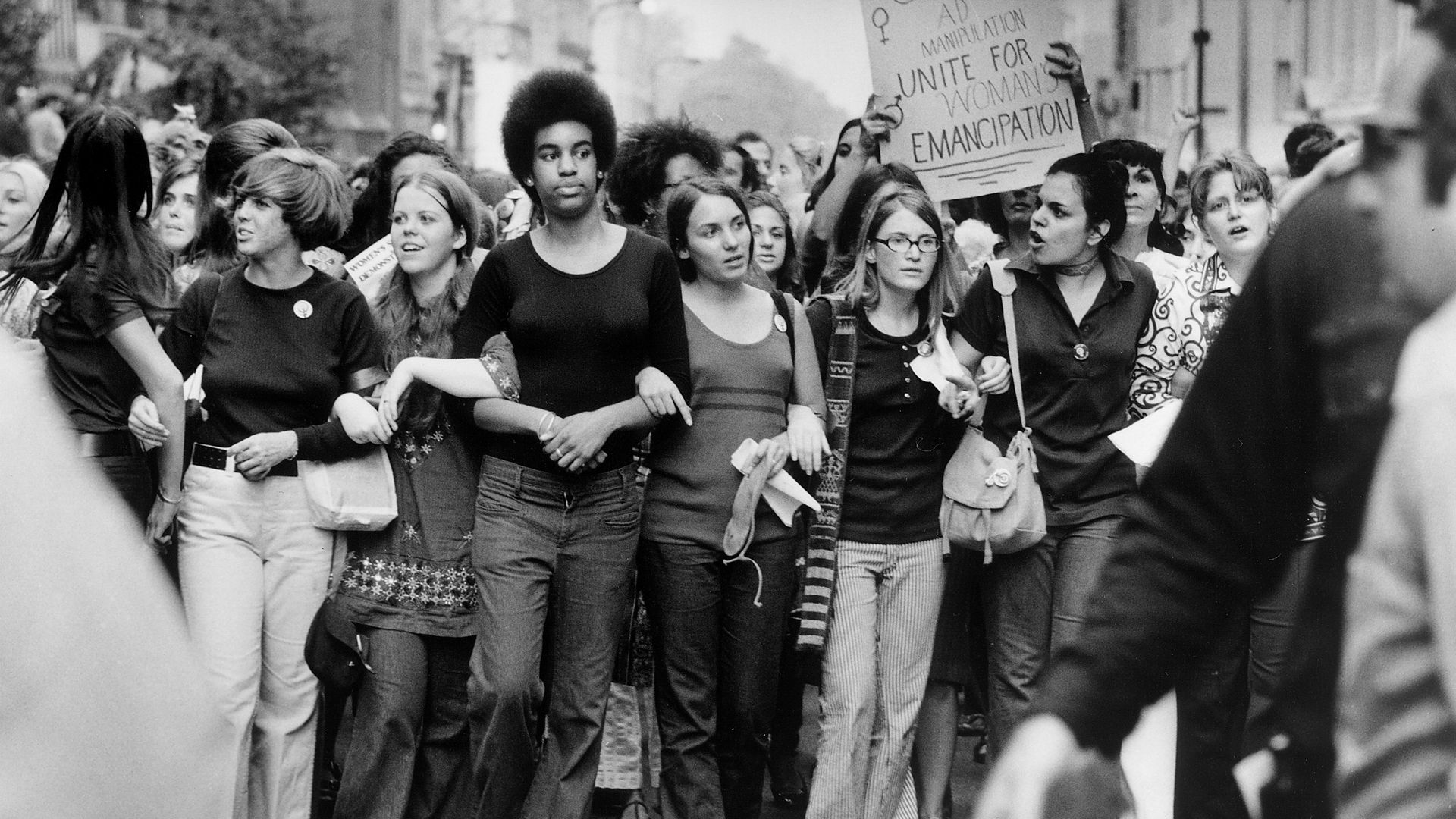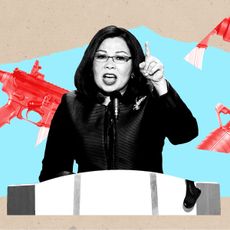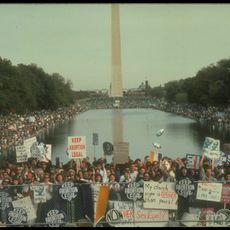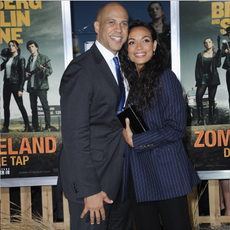

Celebrity news, beauty, fashion advice, and fascinating features, delivered straight to your inbox!
Thank you for signing up to . You will receive a verification email shortly.
There was a problem. Please refresh the page and try again.
The feminist movement has made huge strides over the years. Still, more than a century since women were given the right to vote, the sad fact of the matter is: We've still got a lot of work to do. Somehow, "feminism" (opens in new tab) remains a controversial word, even though the definition of feminism is impossible to argue with: an effort to make sure every woman and every individual has rights equal to that of a cis white man, no matter their race, religion, gender identification, sexual preference, or anything else.
Sounds like a common-sense cause, right? Well, in spite of a plethora of data proving that women are not treated equally to men in America, many people disagree with the premise of feminism, arguing that women already are equal to men, or that their gains haven't matched men's because they haven't worked hard enough, or that women and men are inherently and biologically different and cannot be compared. Others agree that women's rights are a noble cause, but that men's rights aren't given the same consideration.
In actuality, most feminists consider men also at a disadvantage (opens in new tab) due to the inequality between men and women. When we socialize men to not show sadness and fear, to provide financially and not emotionally, and to not seek mental health help, to name a few examples, we contribute to a culture that harms both men and women. At the same time, men, particularly cis white men, are statistically at an advantage when it comes to earning power, career progression, and a multitude of other factors. Feminism is the hard work that both men and women have to do to level the playing field—even more so now that the COVID-19 pandemic has exacerbated existing inequalities (opens in new tab) between men and women, and for women of color especially.
Here, some of the shocking ways women aren't yet equal to men, both inside and outside of the United States.
1. Women pay more for common household items than men do.
Shampoo, deodorant—even a 10-pack of socks—are among the many products that cost more for women, according to a 2015 analysis (opens in new tab) by Marie Claire.
2. The "pink tax" isn't just for personal care items.
Although things like razors and shampoo are the most egregiously upcharged items (opens in new tab), the so-called pink tax meant that all kinds of items geared at women cost more: Toys and accessories for girls (opens in new tab) were found to be 7 percent higher. Women pay more for clothes and protective gear like helmets (opens in new tab) (not to mention bigger-ticket items like mortgages (opens in new tab)). They even pay more for senior home healthcare products (opens in new tab), meaning they pay more for common items from the beginning to the end of their lives.
In October 2020, New York banned the pink tax (opens in new tab), and 20 states so far have gotten rid of the tampon tax (opens in new tab) (i.e., taxes on period products), so hopefully other states will follow suit. However, H.R. 2048 (opens in new tab), the Pink Tax Repeal Act, died in Congress in 2019.
3. Women make less money than their male counterparts.
Although the pay gap is narrowing, women in the U.S. working full- and part-time make 79 percent of what their male counterparts earn, according to the The National Partnership for Women and Families. It's an even grimmer picture overseas: Women worldwide make 77 percent of the amount paid to men, according to a report (opens in new tab) from the United Nation's International Labor Organization.

4. For Black, Latina, and women of color, the pay gap is even worse.
Black women have to work 19 months to make what white men did in a year (opens in new tab), according to The National Partnership for Women and Families (the current numbers place them as earning $0.64 for every dollar earned by a white, non-Hispanic man). That number is even steeper for Latina women ($0.57 for every dollar). Asian American and Pacific Islander women ($0.52 cents for every dollar), and indigenous women ($0.60 to every dollar).
5. Workplace sexual harassment is so common that it directly contributes to the wage gap.
Workplace sexual harassment and assault is so common that it's driving women, en masse, to resign from their jobs. Reporting such abuse is often unattractive for women due to retaliation and lack of consequences for abusers. Thus, victims feel that in order to prioritize their safety, they must face unemployment, job insecurity, and pay cuts―not to mention the financial sacrifices they make by giving up equity and the potential for upward mobility once they leave their companies.
And what happens to the women who stay in these toxic work environments? Women who stay in jobs where they're being sexually harassed report decreased productivity, greater rates of anxiety and depression, and feelings of disempowerment with regards to negotiating promotions and raises.
6. Corporate hiring processes put women at a systemic disadvantage.
Workplace sexual harassment and the wage gap would be a lot less prevalent if there were more women in management roles, right? So, why not hire more women?
According to Oregon State University's Journal of Management, implicit bias often results in women's resumés being passed over in favor of men's during consideration for executive positions. Interestingly, this bias means that companies frequently hire less qualified candidates (just because they're male, it seems), and suffer significant financial losses as a result.
Even when companies hire internally or within their professional networks, implicit bias makes its way into the process. The Harvard Business Review reports that when companies tap into their inner circles to hire for open roles, it's typically a matter of males contacting their fellow male friends. And because male-dominated fields contain so few women, men solely (often subconsciously) envision other men in open roles. So, when it comes time for people to make shortlists of candidates to consider, those lists are too often bereft of women.
7. Women are underrepresented in government.
Although women make up nearly 51 percent of the U.S. population, only 27 percent of Congress is comprised of women, which—fortunately or unfortunately—makes the current Congress the most diverse in American history (opens in new tab). Worldwide, just 25.5 percent of all national parliamentarians were female as March 2021, according to the U.N. (opens in new tab)
8. Women are the minority in the executive suite.
At Fortune 500 companies, women currently account for just 7.4 percent of CEOs, according to Fortune (opens in new tab). Studies also found that women CEOs of Fortune 500 companies have significantly shorter tenures than male CEOs; women at the top tend to stay in their positions for about 44 months on average compared to the 60 months that men do.
There are, however, some positive changes happening: 49 percent of all Standard & Poor 500 board seats are now occupied by women (opens in new tab); CNBC (opens in new tab) reported that Dallas-based online car auction site Copart added its first female board-member in July, marking 2019 as the first ever year where every S&P company has at least one woman on its board. Never mind the fact that, per CNBC, no women cracked the list of the top five highest paid CEOs in the stock market index. As of 2020, representation of women on boards has increased to only 28 percent.
9. Women are also the minority in the news media.
The Women's Media Center's 2019 edition of The Status of Women in the U.S. Media (opens in new tab) reported that though women comprise 41.7 percent of the overall news media workforce, they aren't being compensated appropriately; gendered pay disparities are still observable in newsrooms of major outlets like the Associated Press, The New York Times, and The Wall Street Journal, with men earning substantially more than women.
10. Women are the minority in the tech sector, too.
In 2019, only 25 percent of American computing jobs are held by women, disclosed Dream Host (opens in new tab) in its annual State of Women in Tech address—and that was actually down substantially from previous years. It can be attributed, in part, to the simultaneously declining number of female college students planning on entering the tech sector; of the women enrolled in universities across the country, just 20 percent were studying engineering, and only 18 percent were computer science minors. That number has since only increased to about 27.3 percent (opens in new tab).
The turnover rate of female employees in tech is also disturbingly high. Whereas only 17 percent of men in the industry leave their company at a given time, 41 percent of women in tech resign from their positions, with 56 percent of that group leaving mid-career.
11. When women enter male-dominated industries, the pay decreases.
As women make the cross over into workspaces mostly occupied by men, often in search of higher salaries with more benefits, the opposite actually happens—the average pay for the industry tends to drop significantly over time, confirms The New York Times (opens in new tab).
12. Female entrepreneurs receive less funding and investments.
Getting funding for a startup is hard enough, but sexism and gender inequality often complicate starting one's own business even further. According to findings from All Raise (opens in new tab), a nonprofit organization dedicated to the success of female entrepreneurs, only 11 percent of venture capitalists are women (and other sources actually have that number as even lower (opens in new tab)). Of the existing VC firms, 71 percent don't have a single female partner, and only 7 percent have equal gender representation.
Women interested in running their own startup usually meet difficulties when it comes to securing the capital, and All Raise predicts that the number of female VCs will continue to plateau and possibly even decrease over time if nothing is done to change the current industry.
13. Women still shoulder more of the household burden.
Despite the fact that women are more educated and more employed than ever before, they're still tasked with the majority of household duties. Forbes (opens in new tab) reported that 54 percent of women take maternity leave, while just 42 percent of men take time away from their jobs. Additionally, women are taking 10 times as much temporary leave to be with their newborns than men do, often saddling them with additional financial burdens. Women are also more likely to work from home, look after sick kids, or even quit their jobs completely to be caretakers.

14. Only 10 countries offer women full legal protections.
Speaking of protections around motherhood, according to a 2021 World Bank study (opens in new tab), the U.S.'s lack of laws around parental leave, equal pay, and equal pensions meant it didn't even crack the top 30 countries that offer women full legal equality with men. In fact, only 10 countries scored a perfect 100 percent in terms of legislation ensuring equality: Belgium, France, Denmark, Latvia, Luxembourg, Sweden, Canada, Iceland, Portugal, and Ireland. The U.S. scored a 91.3 percent, right alongside Taiwan, Cyprus, and Albania.
15. Women are more likely to be injured in car crashes.
And the reason why is depressing and infuriating. A 2011 New York Times article (opens in new tab) found that women were 47 percent more likely to be injured in car crashes because the safety features were—you guessed it—designed for men. In 2021, a new study (opens in new tab) by the Insurance Institute for Highway Safety (IIHS) found that women are still much more likely to be injured, despite men driving more and exhibiting more reckless behavior behind the wheel. Women are three times as likely to get a moderate injury and twice as likely to be severely injured. The underlying cause here was behavior: Men tended to drive larger cars and be the car that struck another vehicle. Another not-so-fun fact? Women pay more for cars (opens in new tab) and car insurance (opens in new tab), despite this.
16. Women are far more likely to be the victims of human trafficking.
In a 2019 article, NPR (opens in new tab) reported on the disturbing recent uptick in human trafficking. Using data from an annual report conducted by the United Nations Office of Drugs and Crime (UNODC), the study found the number of girls forced into trafficking has risen exponentially, most frequently for sexual exploitation.
Sexual exploitation remains the most common form of human trafficking; forced labor isn't far behind.
17. Many female soldiers face harassment and sexual assault.
In a Smithsonian (opens in new tab) study conducted in conjunction with American military newspaper Stars and Stripes, 66 percent of female service members reported experiencing sexual harassment or sexual assault—and that number is way up from the 27 percent that the Defense Department reported in 2015.
18. Women overall are at a greater risk of rape and domestic violence.
The National Domestic Violence Hotline (opens in new tab) reports that females ages 18 to 24 and 25 to 34 generally experienced the highest rates of intimate partner violence (IPV). Eighty-one percent of these women (who may have experienced rape, stalking, or physical violence by an intimate partner) reported significant short- or long-term impacts such as post-traumatic stress disorder symptoms and injury.
19. Retired women are twice as likely as retired men to live in poverty.
As women make less money but live longer, a clear issue presents itself: The longer a woman is on earth, the more money she needs to have in order to survive. Around three out of seven women who want to retire by age 67 will seriously struggle with saving, says CBNC (opens in new tab). Survey results from Aon, a global risk, retirement, and health consulting company, show that most women have an average of about 7.6 times their salary saved by that age when they really need to save 11.6 times what they make annually.
20. Women of all ages are more likely than men to live below the poverty line.
Across the U.S., 15.5 percent of women live in poverty compared with 11.9 percent of men, according to a report from the Institute for Women's Policy Research. That number worsens for Black, Latinx, and Native American women. Worldwide, the majority of the more than 1 billion people living in poverty are women, according to the U.N. (opens in new tab) Furthermore, because climate change disproportionately impacts the world's poor, women are far more vulnerable to the food insecurity, instability, and homelessness brought about by the effects of climate change.
21. Women and girls face more chronic hunger.
It's estimated that 60 percent of chronically hungry people around the world are women and girls, and it can be a statistic that's a trickle-down effect of larger problems of gender inequality like lack of education, lack of job opportunities, and violence against women. According to WFP Gender Policy and Strategy (opens in new tab), high food prices, climate change, and economic instability exacerbate existing inequities. It's not solely a global trend: Women disproportionately experience hunger (opens in new tab) in the United States when compared to men. In this country, 26.6 percent (opens in new tab) of families with a single mother live below the poverty line and are more likely to be food insecure at 31.6 percent (opens in new tab) (compared to 14.9 percent and 21.7 percent for single fathers, respectively).
22. Women spend more on health insurance and healthcare.
Because women have children and live longer, historically they've been considered higher "risks (opens in new tab)" from a health insurance perspective—meaning they've been charged more. Despite the Department of Health and Human Services (HHS) (opens in new tab) issuing a ruling prohibiting discrimination in health insurance and healthcare in 2013, women still pay more (and get less) from health insurance and their healthcare usage. Data from the Kaiser Family Foundation and Journal of the American Medical Association (opens in new tab) in 2019 showed that women paid $1,500 more on average on healthcare every year, and yet also skipped out on preventative treatments and other treatments due to cost.
23. Yet female pain and medical issues are not taken as seriously as they are for men.
Did you know that the word "hysteria" has its roots in the Greek term for "uterus"? Well, it seems that in spite of several centuries of gained wisdom about women's high pain threshold, there remains an outrageous societal tendency to underestimate women's pain. Harvard Medical School reports that, on average, women with abdominal pain can expect to wait at least 65 minutes in emergency rooms before being treated for abdominal pain, whereas men can expect to wait 49 minutes. In many cases, women may not be treated or seen by doctors at all, which can have fatal consequences: Women are 7 times more likely to be misdiagnosed and discharged from the hospital while they are having a heart attack, according to The New England Journal of Medicine. Male doctors have been known to blame severe physical pain on things like stress, relationship problems, or the dreaded phrase: "You're just emotional."
This phenomenon is even worse for women of color. Take, for instance, the case of Joyce Echaquan, an indigenous Canadian woman with a pre-existing heart condition who, upon visiting the hospital, was taunted with racial slurs, given strong sedatives, and then left unsupervised. She died in that hospital of an entirely preventable pulmonary edema.
24. Women experience medical side effects to a disproportionate degree because drugs are designed for male bodies.
According to the University of Chicago, women are often excluded from clinical trials for medications because the unfounded (and disproven since 2014) belief that females' hormonal cycles skew test results. Not only are women excluded from clinical trials during later stages of medical research, but labs go so far as to use male mice instead of female mice during early stages of development. Even our basic understandings of illness and symptoms of disease are based on male physiology.
As a result, women are often misdiagnosed and overmedicated, ending up with higher concentrations of medication in their blood than men with the same prescriptions. UC Berkeley found that in 90 percent of cases, women experienced side effects twice as often as men, including cognitive deficits, declines in mental health, nausea, headaches, hallucinations, and cardiac problems.
25. Women are far less represented in STEM.
According to the American Association of University Women (AAUW), women are discouraged from a young age from pursuing careers and academic interests in STEM (science, technology, engineering, and mathematics). Much of this is due to implicit biases that careers in the humanities are feminine while careers in STEM are more masculine. Currently, women make up only 28 percent of the STEM workforce. While this is far better than the 1970s, when women comprised only 8 percent of Americans in STEM, these female professionals still face substantial challenges like workplace sexism, lower pay, a lack of mentorship, and even sexual harassment and assault (take, for instance, the recent allegations against tech company Activision).
26. Women in Hollywood aren't given the same opportunities as men in the industry.
Behind the scenes, women working in Tinseltown make up only a small portion of the workforce; according to the New York Film Academy's 2018 Gender Inequality in Film Infographic (opens in new tab), the ratio of men to women working on films is 5 to 1. There are seven times as many men writing film scripts as there are women, and women only account for 11 percent of directors in Hollywood across genres.
27. Women aren't paid anywhere near as much in Hollywood, either.
Back in 2018, the film All the Money in the World made headlines, but not for the reasons one would expect. It was revealed that Mark Wahlberg made $5 million to do necessary reshoots for the movie while his co-star Michelle Williams only received $625,000. Shocking, but not at all uncommon in Hollywood: Forbes (opens in new tab) reported that actresses earned only about 35 cents on the dollar compared to their male counterparts in the industry.
28. Despite being as successful as male athletes, women in sports still face gender inequality.
The United Nations Educational, Scientific and Cultural Organization (opens in new tab) (UNESCO) studied sports coverage and found that there were significant differences in the way that female athletes and their games were discussed in the sports media. Coverage of women in sports, says the organization, is often dominated by references to appearance, age, or family life—men are depicted as powerful, independent, dominating, and valued as athletes.
Besides gendered conversations by sports pundits, female athletes are still trying to fight against the wage gap that exists in the sports world. Most notably, the United States Women's Soccer team recently filed a lawsuit (opens in new tab) against the U.S. Soccer Federation (USSF) alleging gender discrimination. Despite winning more games and bringing in more revenue than the U.S. Men's team, Megan Rapinoe and her comrades on the USWNT earn less than half of what the men do. Part of the lawsuit was dismissed in 2020 (opens in new tab) and was only recently, upon appeal, settled.
29. And women's sports are vastly under-funded to begin with.
According to the Women's Sports Foundation, girls and young women have 2.1 million fewer opportunities than their male counterparts to participate in sports, and are more likely to quit sports at a young age due to lack of funding and rapidly decreasing quality in sports programs. As someone who played sports as a kid, I can attest to this: While the boys' soccer team in my high school was coached by a former Division 1 soccer coach, the girls' team was coached by our campus security guard, who openly admitted that he'd never played soccer before and often forgot the word "cleats."
In the United States, Title IX is supposed to be a robust measure ensuring that women's sports receive the same funding and attention as men's sports, but that's simply not the case. In reality, while women make up more than 50 percent of NCAA athletes, they receive only 28 percent of athletic money and 42 percent of athletic scholarships, while men's programs receive 2.5 times the amount of basic funding.
Why, you may ask, are sports so important for women? Women who play sports during and before college report higher rates of confidence and positive self-image (opens in new tab), and are less likely to develop serious health conditions like breast cancer later in life.
30. Women are woefully undereducated about their own bodies and sexualities.
The sex education in this country is a disgrace. I, like many Americans, was taught abstinence-only sex education, meaning that there was no discussion about recreational sex or female pleasure, and contraceptives were talked about as unnatural, last-resort options that were inferior to total abstinence. Countless reputable sources, including Columbia University and the Journal of Adolescent Health, have condemned this sort of education, citing that these tactics "violate adolescent human rights, withhold medically accurate information, stigmatize or exclude many youth, reinforce harmful gender stereotypes, and undermine public health programs."
Not only does sex-shaming sex ed (or a lack of sex ed altogether) result in increased rates of teen pregnancy, STD infection rates, and sexual assault among young women, but they also have consequences that reverberate through the rest of women's lives. When sex ed discusses sex as an act that ends with the culmination of male pleasure, it decentralizes the female experience and takes the possibility of feminine pleasure out of the conversation entirely. This is often why women never figure out what feels good for them, and end up putting up with abusive, dangerous behavior in the bedroom or having sex they describe as "chore-like."

Gabrielle Ulubay is an E-Commerce Writer at Marie Claire and writes about all things fashion and beauty. She's also written about politics, gender, and sex for publications like Bustle, HuffPost Personal, and The New York Times. As a film school graduate, she loves all things media and can be found making art when she's not busy writing.
-
 How to Minimize Your Pores, According to Dermatologists
How to Minimize Your Pores, According to DermatologistsSay goodbye to the gunk.
By Samantha Holender
-
 Why Homemade Sex Toys Are Always a Bad Idea
Why Homemade Sex Toys Are Always a Bad IdeaSafety is sexy.
By Gabrielle Ulubay
-
 Prince Charles Candidly Reacts to His Portrayal on “The Crown”
Prince Charles Candidly Reacts to His Portrayal on “The Crown”The hit Netflix series’ fifth season drops later this year—with the Prince of Wales as a main character.
By Rachel Burchfield
-
 Why the 2022 Midterm Elections Are So Critical
Why the 2022 Midterm Elections Are So CriticalAs we blaze through a highly charged midterm election season, Swing Left Executive Director Yasmin Radjy highlights rising stars who are fighting for women’s rights.
By Tanya Benedicto Klich
-
 Tammy Duckworth: 'I’m Mad as Hell' About the Lack of Federal Action on Gun Safety
Tammy Duckworth: 'I’m Mad as Hell' About the Lack of Federal Action on Gun SafetyThe Illinois Senator won't let the memory of the Highland Park shooting just fade away.
By Sen. Tammy Duckworth
-
 Roe Is Gone. We Have to Keep Fighting.
Roe Is Gone. We Have to Keep Fighting.Democracy always offers a path forward even when we feel thrust into the past.
By Beth Silvers and Sarah Stewart Holland, hosts of Pantsuit Politics Podcast
-
 The Supreme Court's Mississippi Abortion Rights Case: What to Know
The Supreme Court's Mississippi Abortion Rights Case: What to KnowThe case could threaten Roe v. Wade.
By Megan DiTrolio
-
 Sex Trafficking Victims Are Being Punished. A New Law Could Change That.
Sex Trafficking Victims Are Being Punished. A New Law Could Change That.Victims of sexual abuse are quietly criminalized. Sara's Law protects kids that fight back.
By Dr. Devin J. Buckley and Erin Regan
-
 My Family and I Live in Navajo Nation. We Don't Have Access to Clean Running Water
My Family and I Live in Navajo Nation. We Don't Have Access to Clean Running Water"They say that the United States is one of the wealthiest countries in the world. Why are citizens still living with no access to clean water?"
By Amanda L. As Told To Rachel Epstein
-
 Her Love of Basketball Left Her Stateless
Her Love of Basketball Left Her StatelessOne athlete’s quest for freedom from Afghanistan, where the Taliban's restrictive and regressive policies on women's sports put her life in danger.
By Abigail Pesta
-
 Cory Booker and Rosario Dawson's Relationship Is No More
Cory Booker and Rosario Dawson's Relationship Is No MoreAfter three years of dating, the power couple have decided they're better off as friends.
By Marie Claire Editors










